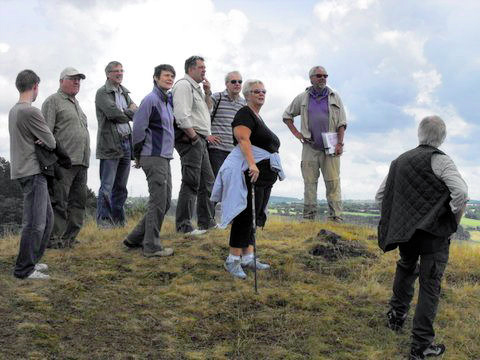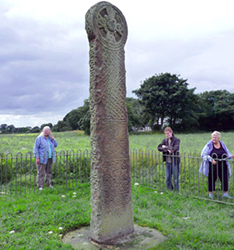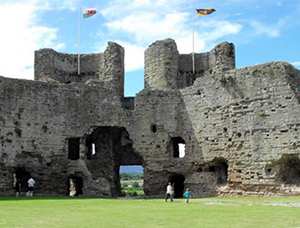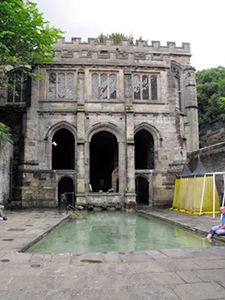
What a great day we had on our Summer Trip this year. In the morning we visited the Iron-age Hill Fort at Bodfari, which was a steep climb but well worth it. We were met at the top by Gary Lock, Professor of Archaeology at Oxford University, who has been excavating the site for a few seasons now. On the south side his excavations across the outer bank have revealed tentative evidence of a stone wall, which would have acted as a revetment. Excavations near the entrance to the site on the north side have also revealed evidence of a round house. These would have made quite an impressive sight as you came through the gateway. Previous season work (now covered over) revealed a substantial cobbled surface, but finds were quite rare.
However Gary and his team are confident they will be able to discover more to describe the people that lived there, the period the site was occupied and for how long. This was a rare opportunity to visit an ancient monument which is on private land. I would therefore like to thank Gary for allowing us this privilege and making it a great day.
Our second site was Rhuddlan Castle where we had our picnic lunch. Edward I invaded North Wales in the summer of 1277 from his base at Chester. By late August he had reached Rhuddlan where he proceeded to erect this magnificent castle. Llywelyn, Prince of Wales surrendered in the following month, though hostilities continued until his death in 1283. The castle also saw action in the Civil War, eventually being rendered useless by Parliament forces.

Our next site was St Winefride's Well at Holywell. According to legend, this is the site where, whilst defending her honour, she lost her head, cut off by Caradog - later restored to life by the prayers of her uncle St Beuno. Winefride lived as a nun until her second death 22 years later. The present shrine, a Gothic 2-storey building in the late Perpendicular style, was erected in the early 16th century, and is unique in the world. It is a Grade I Listed Building and a Scheduled Ancient Monument (it was tempting to sooth our aching limbs in the cool water but no bathing was allowed on the day).
Our final site was to have been Basingwerk Abbey in the grounds of the Greenfields Heritage Park. However at this point our luck with the weather ran out and the heavens opened. As it was getting quite late, we decided to call it a day (the consensus was that we'd already had a great trip and Basingwerk could wait for another day). |

Our next site was the impressive Celtic Cross at Maen Achwyfan (see over page) which lies just a mile or two west of Whitford. This 12ft high monolith, with carvings similar to Celtic and Viking styles, is believed to be the tallest wheelcross in Britain and thought to date from 1000 AD.
 |
Next Meeting
Wednesday 4th September - in the Standish Suite at the Brocket Arms (7.30pm as usual). This month we have Derek Winstanley, a local historian who now lives in America. He is over here for a short visit and has agreed to give us a talk at short notice. This year marks the 200th anniversary of the first operation of a steam locomotive in Lancashire. This was Daglish's famous Yorkshire Horse and ran on Clarke's Wagonroad which crossed the Pingot Valley just south of Pemberton. It is here where we have been carrying out recent investigations (see newsletter No.164) to locate a lime kiln and the famous Pingot Well. Derek's research has revealed that the viaduct Clarke built for the railway was quite possibly the first stone built viaduct in the world to carry a steam locomotive. It's bound to be a great talk - hope to see you there. BA.
New Chairman Required
Very sad to hear that Eric Walter has decided to step down as chairman of the Society. Eric has been in the post since November 2009, seeing us through some very difficult times particularly when we lost our previous chairman.
Eric has also made a great contribution to the Society setting up and running various projects, in particular the Rectory project. His 'Desk Based Assessment' and 'Project Plan' are object lessons in how these things are done. He also carried out a recording programme and watching brief on the Parish Church Graveyard for which we received our Society camera. He has recently begun a number of research based projects which do not involve excavation (for those less active members) but drawing on a wider range of archaeological skills. To progress this, earlier this year we obtained our new plane table surveying equipment, and have already used it successfully on both the Kirkless and Pingot sites. Also, due to Eric's initiative, Dave Horrocks has produced a new database for recording Routeway Furniture and other research data.
I'm sure everybody will join me in thanking Eric for his efforts and support over the years and wishing him all the best for the future. We are now looking for a new chairman. If you are interested please contact me at the meeting.
|



